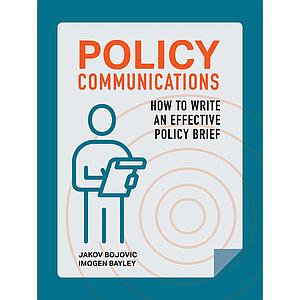Product details
- Categories: May 2025, EU COMPETITIONS, Job Profiles
- Publisher: John Harper Publishing
- ISBN: 9781068440908
- Publication Date: 23/05/2025
- Binding: Paperback
- Number of pages: 144
- Language: English
Summary
In an era of information overload, great ideas alone aren’t enough — how you communicate
them determines whether they shape decisions or get ignored. This book gives you the tools
to ensure your policy briefs are read, understood, and acted upon.
The book is designed to help policymakers, researchers, advocacy professionals,
communications specialists, and anyone who needs to turn complex ideas into clear,
compelling, and actionable policy communications.
The coverage includes:
• Strategies for cutting through the noise and capturing the attention of busy
policymakers
• Insights on audience targeting, messaging, and policy storytelling
• Practical frameworks for structuring, writing, and designing impactful policy briefs
• A step-by-step approach to crafting effective policy briefs
• The role of generative AI in policy writing
Table of contents
CHAPTER 1: THE MANY CHALLENGES OF POLICY COMMUNICATIONS
What is ‘policy communications’?
The battle for attention
1. 1. Challenge 1: Catching and maintaining attention
1. 2. Challenge 2: Research in competition
1. 3. Challenge 3: The skills gap
1. 4. How to read this book
CHAPTER 2: EFFECTIVE POLICY COMMUNICATIONS: FROM STRATEGY TO
EXECUTION
2. 1. Understanding the policy landscape.
2. 2. Arriving at policy positions through research, analysis,
and/or consultation
2. 3. Policy communications strategy
2.3.1. Defining our audiences
2.3.2. Targeted messaging
2.3.3. Objectives
2.3.4. Outputs and evaluation
2.3.5. Examples of policy communications strategies
2. 4. Crafting impactful policy narratives
CHAPTER 3. HOW TO WRITE EFFECTIVE POLICY BRIEFS
3. 1. Context: Knowing your audience
3. 2. Structure: Taking your audience on a journey
3.2.1. Title
3.2.2. Executive summary
3.2.3. Background
3.2.4. Policy proposal
3.2.5. Ending
3. 3. Evidence: Convincing your audience
3. 4. Writing: Engaging your audience
3.4.1. Principle C1: Clear
3.4.2. Principle C2: Concrete
3.4.3. Principle C3: Confident
3.4.4. Principle C4: Coherent
3.4.5. Principle C5: Cohesive
3.4.6. Generative AI and policy writing
3. 5. Visuals: Keeping your audience awake
3. 6. Policy briefs and impact
4. CONCLUSION.
BIBLIOGRAPHY
